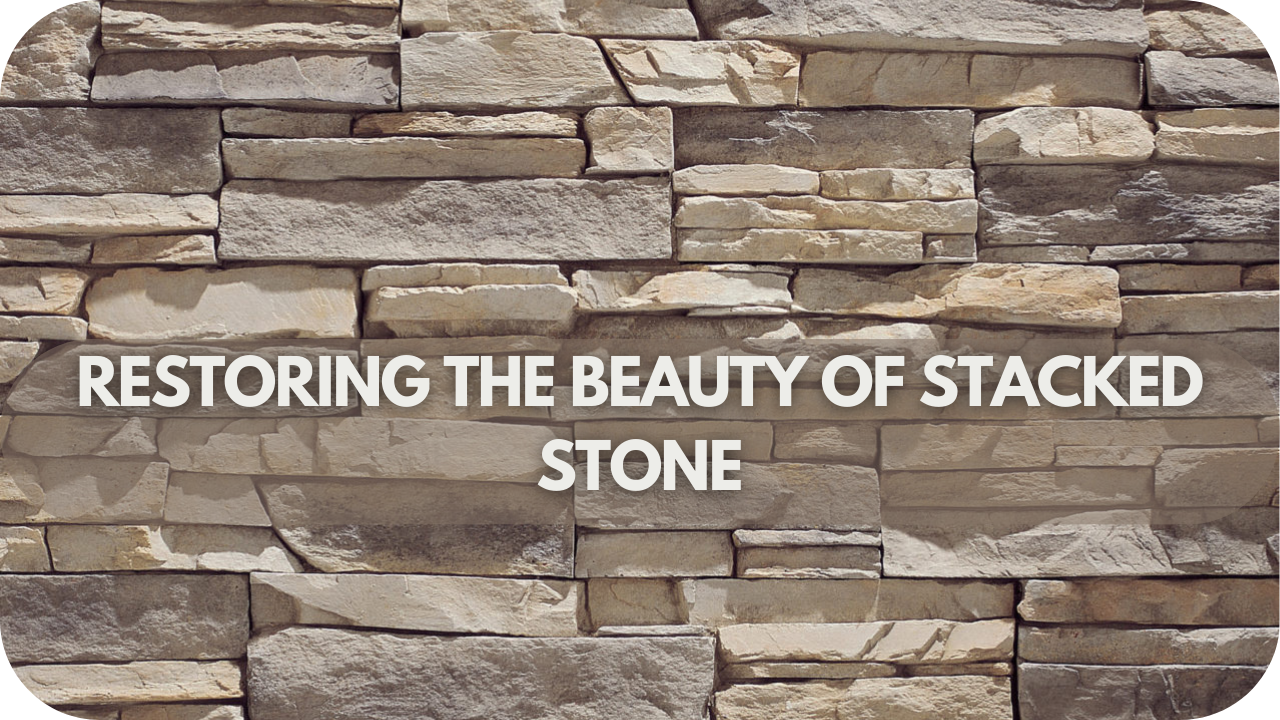
Restoring the original charm of stacked stone can be challenging when cracks, fading, and discolouration start to appear. These issues not only affect the stone’s visual appeal but can also compromise its durability over time.
Proper care and targeted restoration techniques are essential to maintaining its timeless beauty. From repairing cracks to reviving faded hues, addressing these concerns can breathe new life into your stone surfaces, ensuring they continue to enhance your space for years to come.
Why Does Stacked Stone Lose Its Appeal?
Have you ever wondered why that once stunning stacked stone looks dull and weathered? Understanding the hidden reasons behind its fading charm could save your next project.
- Weathering: Prolonged exposure to sunlight, rain, and temperature fluctuations can lead to fading and discolouration, diminishing the stone’s natural vibrancy.
- Moisture Absorption: Water infiltration can cause internal damage, such as cracks or efflorescence, a white, powdery residue on the stone’s surface.
- Installation Issues: Improper techniques or inadequate sealing allow water to seep into the stone, exacerbating damage.
- Wear and Tear: Daily use can dull the stone’s natural sheen, diminishing its original charm.
- Dirt and Pollutants: Grime can build up over time, masking the stone’s texture and colour.
- Freeze-Thaw Cycles: Expansion and contraction due to temperature changes can result in surface cracks.
- Chemical Reactions: Cleaning agents or nearby landscaping chemicals may discolour or etch the stone.
- Neglected Maintenance: Without regular cleaning and resealing, the stone deteriorates faster, losing its aesthetic appeal.
Signs Your Stacked Stone Needs Restoration
Cracks, fading, and discolouration indicate that your stacked stone requires restoration.
1. Cracks
Cracks in stacked stone are a clear indicator that restoration is required. When you see small fissures or deeper splits, it signals potential structural concerns.
Over time, temperature fluctuations can widen these cracks, allowing moisture to penetrate further. This moisture can freeze and expand, leading to more extensive damage. At times, you might notice parts of the stone beginning to loosen or shift.
Discoloured patches often accompany these cracks, showing water has seeped inside. Left unattended, even minor cracks can compromise the stability of your stone feature.
2. Fading
Fading is a common sign that your stacked stone requires attention. Prolonged exposure to direct sunlight can dull the stone’s vibrant colours over time.
Notice if your stone’s surface appears bleached or washed out; this typically indicates UV damage. The contrast between faded and unfaded sections can become more pronounced in shaded areas, highlighting the wear.
Sometimes, fading can be uneven, giving the stone a patchy appearance. A once-rich surface may lose its depth, diminishing the overall aesthetic. Addressing fading promptly helps restore the stone’s original beauty and prevents further damage.
3. Discolouration
The discolouration is a clear indication that your stacked stone may need restoration. Dark patches often signal moisture absorption, where water has seeped into the stone, leading to uneven colouring.
Over time, minerals within the water can deposit on the surface, creating unsightly stains. In some cases, algae or mould growth can cause greenish or blackened areas, especially in damp environments.
A yellowish tint might suggest chemical reactions with cleaning agents or environmental exposure. This colour shift can make your stone appear aged and neglected.
How to Restore Stacked Stone
Is your stacked stone looking worn out and dull? Discover the secrets to restoring its original charm and strength with these expert restoration tips.
1. Surface Cleaning
Begin the restoration process by thoroughly cleaning the stone surface. Use a pH-neutral stone cleaner, which is gentle enough to avoid damaging the stone while effectively removing surface contaminants like dirt, grime, and organic growth such as algae.
Apply the cleaner evenly and scrub the surface with a soft-bristle brush, focusing on areas with stubborn buildup. Avoid harsh chemicals or high-pressure washers, which can damage the stone’s natural texture.
Rinse thoroughly with clean water and let the surface dry completely before proceeding to the next steps.
2. Crack Repair
If left untreated, cracks in stacked stone can worsen over time, allowing moisture to penetrate and cause further damage. To repair cracks, use a stone epoxy or mortar that closely matches the stone’s colour and texture.
Begin by cleaning out any debris from the crack. Using a putty knife, apply the epoxy or mortar, pressing it firmly into the crack to ensure a strong bond. Smooth out the surface with the putty knife for a seamless finish, blending it with the surrounding stone.
Allow the repair to cure entirely according to the manufacturer’s instructions before continuing with further restoration steps.
3. Colour Restoration
Over time, exposure to the elements can cause the stacked stone to lose its vibrant colour. To revive faded hues, apply a high-quality stone enhancer.
These enhancers penetrate the stone’s surface, restoring its natural richness and deepening the existing colour. Using a clean cloth or brush, apply the enhancer evenly over the stone’s surface, working in small sections to avoid streaks.
Allow the product to soak in as directed, then wipe away any excess to prevent a glossy finish unless desired. Stone enhancers also offer protection against future UV damage, helping to maintain the stone’s appearance longer.
4. Stain Removal
A poultice is an effective solution for tough, deep-set stains like oil, rust, or organic discolouration. It is created by mixing a cleaning agent with an absorbent material, such as baking soda or clay.
Apply the paste to the stained area, covering it with plastic wrap to keep it moist. Allow the poultice to sit on the stain for up to 24 hours. It draws the stain out from the stone’s pores as it dries.
Remove the poultice, rinse the area with water, and repeat if necessary until the stain is fully lifted. Ensure the stone is dry before proceeding to sealing.
5. Sealing
Sealing protects the restored stone from moisture, UV rays, and environmental damage. Select a high-quality penetrating sealer specifically formulated for natural stone.
Apply the sealer evenly using a brush or roller, ensuring complete coverage, especially in joints and seams where moisture may penetrate. Allow the sealer to soak into the stone, then wipe away any excess to avoid a film build-up.
Let the sealer cure per the product instructions, typically for 24 to 48 hours. Proper sealing extends the life of the stone, helping it withstand the elements while maintaining its fresh look.
6. Routine Maintenance
After restoration, maintaining the stone is essential for preserving its appearance and integrity. Clean the stone surface regularly with a pH-neutral cleaner to prevent dirt buildup and avoid harsh chemicals that could damage the surface.
Reapply the stone sealer every two to three years or as the manufacturer recommends to maintain its protective layer. Inspect the stone periodically for signs of new cracks, fading, or stains, addressing these issues promptly to prevent more extensive repairs.
Routine care keeps the stone looking vibrant and extends its lifespan, ensuring it remains a durable feature of your space.
The Benefits of Restoring Stacked Stone
Reviving the natural beauty of stacked stone enhances the look of your space and can breathe new life into your entire property. Discover why restoring stacked stone is the key to preserving its timeless charm and strength.
1. Revitalises Natural Beauty
Restoring stacked stone can bring back the vibrant colours and natural textures that may have dulled over time. Cleaning, polishing, and using stone enhancers help revive the original look, making the stone appear as fresh and lively as it did when first installed.
This process eliminates stains and discolouration, ensuring the stone remains an eye-catching feature in your space. A restored stone surface adds a sense of refinement, enhancing the overall aesthetic of both indoor and outdoor settings.
2. Strengthens the Structure
Addressing structural issues like cracks during restoration is crucial for maintaining the integrity of the stacked stone. Cracks can allow moisture to penetrate, leading to internal damage that compromises the stone’s stability.
Suitable repair materials like epoxy or mortar can seal these cracks and prevent them from expanding further.
3. Applies a Protective Sealant
Applying a protective sealant is an essential step in the restoration process. The sealant acts as a barrier, preventing moisture from seeping into the stone, which can lead to mould growth, efflorescence, and surface stains. It also helps guard against future UV damage, preserving the stone’s colour.
4. Increases Property Value
Well-maintained and restored stone surfaces can significantly boost a property’s value. Potential buyers are often drawn to homes with beautiful, durable materials like natural stone.
An adequately restored stone feature, such as a wall or fireplace, creates a lasting impression of quality and care. It adds a touch of luxury, making the space more appealing and potentially increasing the property’s market value.
5. Reduces Maintenance Needs
Restoration makes ongoing maintenance of stacked stones much more manageable. With cracks sealed and the surface protected, frequent repairs are less needed.
A properly sealed stone surface is also more resistant to dirt and staining, making cleaning easier.
This reduces the time and effort required for upkeep, allowing homeowners to enjoy the beauty of their stone features without constant maintenance concerns.
Preventative Maintenance Tips for Stacked Stone
Want to keep your stacked stone looking flawless for years to come? These preventative maintenance tips will save you time, money, and headaches.
- Routine Cleaning: Use a pH-neutral cleaner and a soft brush to remove dirt and debris without damaging the surface.
- Apply a High-Quality Sealant: Reseal every two to three years to protect against moisture and UV damage and prevent fading and discolouration.
- Inspect for Cracks and Chips: Check regularly, especially after harsh weather, and repair minor issues before they worsen.
- Use Covers During Extreme Weather: Protect outdoor stacked stone from heavy rain or freezing temperatures with covers.
- Ensure Proper Drainage: Prevent water from pooling around the stone to avoid moisture damage over time.
Conclusion
Restoring the beauty of your stacked stone revitalises its look and enhances its longevity. Addressing cracks, fading, and discolouration ensures a durable and appealing feature that stands the test of time. Don’t let your stone lose its charm—take action today to restore and protect it for years. Reach out for expert advice, or begin your DIY restoration now!
More To Explore

Stone Accents: Adding Charm to Modern Interiors with Natural Stone
Modern interiors seek a balance of style, durability, and uniqueness. Natural stone accents are a game-changer, adding timeless elegance and character to any space. As

Natural Stone Features That Will Transform Your Living Room
Natural stone elevates any living room with elegance, texture, and timeless appeal. Its versatility allows it to enhance both modern and traditional spaces. From stone


